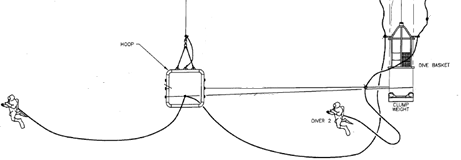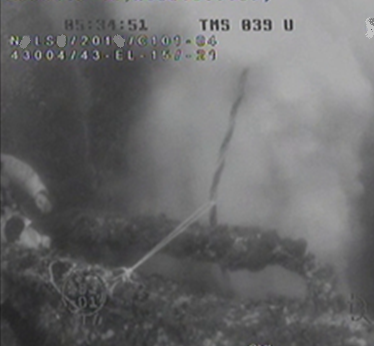Near-miss: Fouled diver umbilical
A member has reported an incident in which a diver’s umbilical became fouled around a seawater discharge caisson. The incident happened during a shallow water saturation dive (15msw), whilst using extended umbilicals routed through a submerged intermediate hoop to reach the worksite from the diving bell.
The diver had made his way to the structure through the hoop. He was preparing to move into the structure by pulling the required length of slack umbilical through to his location at the edge of the structure, before moving to the work location. This meant the diver had to pull through approximately 23m of working umbilical in order to access the job, which was in the centre of the jacket. The umbilical was slightly negatively buoyant. Whilst the diver was pulling through the 23m of working slack at the jacket, a bight formed below him. The bight was carried by the prevailing current (which was setting towards the aerated discharge), and was drawn into the aerated discharge. As the caisson base was only 2m below the 15m elevation, the aerated water lifted the bight of umbilical upwards and around the caisson resulting in diver 2 being unable to pull through his slack.
The platform was subsequently shut down to allow the umbilical to be freed. Both divers then returned safely to the diving bell and the bell was recovered to the vessel.



Our member noted the following contributory or underlying causes:
- The risk assessment identified the caisson as a hazard, but did not identify the aerated nature of the water around the caisson discharge as a hazard;
- The risk assessment did not identify that ‘safe’ standoff distances should take into account the maximum length of a diver’s ‘slack’ umbilical that could be deployed in conjunction with tidal direction etc., when establishing safe standoff distances;
- The aerated nature of the water was considered a nuisance rather than a hazard with regard to the diver’s umbilical.
The following lessons were learnt:
- Take into account the length and potential route/location of the diver’s umbilical in relation to discharges and other hazards (inlet and outlets, snagging points) in addition to the physical location of the diver;
- Understand that gas entrained discharges can produce significant general upward flow of the surrounding water in their location even if the outflow from the discharge is downward.
Our member suggested the following immediate actions:
- Ensure all potential hazards are considered during umbilical management – and not just vessel thrusters;
- Take into account diver routing and access and umbilical management techniques during pre-job engineering;
- Ensure specific review of the risks of working on extended umbilicals and/or within structures is considered during the risk assessment process.
Members may wish to refer to the following incidents (search words: fouled):
Safety Event
Published: 24 February 2016
Download: IMCA SF 05/16
IMCA Safety Flashes
Submit a Report
IMCA Safety Flashes summarise key safety matters and incidents, allowing lessons to be more easily learnt for the benefit of all. The effectiveness of the IMCA Safety Flash system depends on Members sharing information and so avoiding repeat incidents. Please consider adding [email protected] to your internal distribution list for safety alerts or manually submitting information on incidents you consider may be relevant. All information is anonymised or sanitised, as appropriate.
IMCA’s store terms and conditions (https://www.imca-int.com/legal-notices/terms/) apply to all downloads from IMCA’s website, including this document.
IMCA makes every effort to ensure the accuracy and reliability of the data contained in the documents it publishes, but IMCA shall not be liable for any guidance and/or recommendation and/or statement herein contained. The information contained in this document does not fulfil or replace any individual’s or Member's legal, regulatory or other duties or obligations in respect of their operations. Individuals and Members remain solely responsible for the safe, lawful and proper conduct of their operations.
